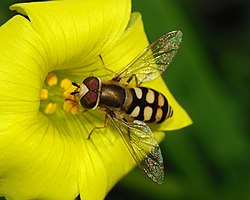This article may be too technical for most readers to understand.(May 2023) |
| Eupeodes | |
|---|---|
 | |
| Eupeodes corollae male | |
 | |
| Eupeodes americanus female | |
| Scientific classification | |
| Domain: | Eukaryota |
| Kingdom: | Animalia |
| Phylum: | Arthropoda |
| Class: | Insecta |
| Order: | Diptera |
| Family: | Syrphidae |
| Tribe: | Syrphini |
| Genus: | Eupeodes Osten Sacken, 1877 |
| Subgenus | |
| |
| Synonyms | |
| |

Eupeodes, the aphideater flies, are a genus of moderate hoverflies in the family Syrphidae. They are distributed worldwide. They are black with yellow markings and can be easily confused with other genera in the Syrphini tribe. Larvae feed on a wide variety of aphids. The adults feed on nectar and pollen as sources of energy and protein, respectively, and often hover over the plants they visit. [1] [2]
Contents
- E. fumipennis female hovering
- E. volucris female hovering

